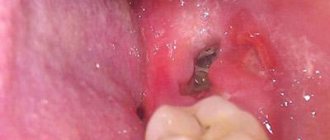Carrying out the procedure
The tooth extraction procedure is carried out using effective, modern painkillers, so, as a rule, there is no pain during the operation itself.
The operation begins immediately after the anesthesia takes effect. A scalpel is used to loosen the ligament supporting the tooth.
If the procedure was traumatic, or the edges of the wound are too wide, the dental surgeon may use self-absorbing sutures. But most often, the wound is simply closed with a gauze pad with a special hemostatic agent. To stop bleeding, you need to lightly but firmly press the tampon onto the wound with closed jaws. After 20 minutes, the gauze can be spat out.
Why can’t stomatitis be treated without the participation of a doctor?
Of course, the use of medicinal ointments and preparations, special lotions and rinses for the oral cavity does not require hospital conditions and strict supervision by doctors. Indeed, you can heal yourself.
However, your decisions and actions should always be in consultation with your healthcare provider. Do not take any action or purchase medications yourself.
One careless mistake can lead to a complicated course of the disease and an increase in the inflammatory process!
Gum condition
Pain in the gums may occur after the anesthetic drug wears off, that is, after 3-4 hours. After the procedure, the patient is often worried about the return of painful sensations and the release of ichor (for 4–6 hours. After the operation, the wound looks quite scary, especially if a wisdom tooth was removed.
In the absence of pathology, the healing process occurs in several stages.
Treatment of stomatitis in adults
It is important to start etiotropic treatment in a timely manner to prevent chronicization of the pathology. Therapy for stomatitis includes a set of measures:
- the symptomatic part of therapy consists of taking antipyretic drugs;
- in case of severe pain, painkillers are prescribed;
- the key stage of treatment is to find and eliminate the root cause of stomatitis: the causative agent or the underlying disease; which helps prevent relapses of the painful condition;
- local treatment involves the use of local agents with a healing and antibacterial effect;
- An important component of the treatment plan is the selection of a diet and the exclusion of products containing aggressive and irritating substances (menthol, sodium lauryl sulfate) from the regimen of regular hygienic treatment of the oral cavity.
A gentle diet includes adding soft fermented milk products, neutral vegetables and fruits, cereal porridges, lean boiled meat and low-fat broths to the diet. Tea and coffee should be avoided; it is recommended to replace them with decoctions, fruit drinks and water. Spicy, sour, hot dishes or food, parts of which can physically injure tissues affected by stomatitis, are excluded. After eating, you should rinse your mouth with water or a medicinal solution.
In cases of recontamination of ulcerated areas of the mucosa, drugs containing chlorhexidine bigluconate are used. Long-term use of these drugs has an unpleasant side effect: dark spots appear on tooth enamel and fillings, which disappear after the end of treatment.
Day after the procedure
At the initial stage, the hole remaining in the place of the pulled out tooth is filled with a scarlet blood clot. It is not recommended to remove it, as it performs several functions:
- protects the wound from infections;
- eliminates bleeding from blood vessels;
- promotes the formation of new tissue that will fill the empty space.
To avoid breaking up the blood clot, it is recommended not to brush your teeth on the day of surgery. Smoking is accompanied by inhalation of smoke, which creates negative pressure in the oral cavity. This may help pull the clot out of the socket. It is not recommended to blow your nose or spit. Rinsing your mouth should also be avoided; you can simply put the solution in your mouth and hold it for a while without rinsing. Gentle rinsing can be indicated only in the presence of inflammatory and purulent processes.
Features of the disease
Currently, dental stomatitis is one of the most common diseases of the oral cavity. If a person discovers an ulcer in his mouth, he needs to see a doctor as soon as possible and identify the causative agent of the disease. Only then can appropriate treatment be prescribed to help prevent future complications.
What are the causes of stomatitis? There may be several of them at once. The main source of the problem is viral, bacterial and fungal infections. Stomatitis can also develop after a serious injury or accident, with constant mechanical damage to the mucous membrane, frequent stressful situations, the presence of chronic diseases, poor nutrition, HIV infection, etc.
Insufficient hand hygiene can cause harmful bacteria to enter your mouth. This usually occurs upon contact with contaminated surfaces and even unwashed vegetables or fruits. Another cause of stomatitis may be the use of certain medications, for example, antibiotics, which tend to disrupt the normal microflora of the oral cavity. The presence of problems with the digestive system, allergies, hormonal disorders, bad habits and much more - all of these are provoking factors.
After three days
The blood clot begins to change and thicken. Gray and white fibrin stripes appear on it, after which the formation of new gum tissue begins. Painful sensations may still occur. But they are much weaker and have a pulling character. The patient may experience bad breath. This is considered normal and is due to the formation of a blood clot. Failure to brush your teeth also leads to the formation of bacteria and an unpleasant odor.
To rinse the mouth, you must use special solutions recommended by your doctor. The appearance of pain from touching the gums, increased pain during eating, serves as a signal for the need to return to the dentist's office. If the tissue of the edges of the hole has acquired a red tint, you should also immediately consult a specialist.
Professional care and disinfection
Treatment of stomatitis that occurs after tooth extraction begins with the elimination of concomitant diseases in the oral cavity and professional teeth cleaning. Then it is necessary to disinfect the surface of the mucous membrane using antiseptics:
- soda solution;
- brilliant greens;
- hydrogen peroxide;
- potassium permanganate solution;
- "Chlorhexidine";
- "Miramistina";
- "Furacilina".
This will minimize the number of pathogenic microorganisms, which will speed up recovery. Before treating stomatitis with any medication, you must obtain permission from your doctor.
After 2–3 months and beyond
The gum gradually hardens, and the space remaining from the tooth is filled with maturing bone tissue. By the beginning of the 4th month, the gum bone tissue completes its formation. The gum can be called completely healed.
If the wound heals with suppuration, then healing of the wound can last up to six months.
Can stomatitis be a side effect after taking medications?
Rare, but still acceptable causes of stomatitis also include taking certain medications.
Some antibiotics, diuretics, and oral contraceptives affect the condition of the oral mucosa, causing increased dryness and other complications. If your mouth becomes very dry, cracks and ulcers may occur.
Gum healing process
The speed of gum healing depends on several factors:
- individual characteristics of the patient’s immunity;
- the success of the operation;
- location of the extracted tooth.
If the tooth is in a hard-to-reach place, has crooked roots, or its crown has been significantly damaged, then the removal procedure becomes more complicated. During manipulation, the tooth may begin to crumble, leaving fragments in the gum. In this case, it is necessary to cut the gum tissue, detach it from the bone, remove the tooth in parts, and use a drill. These traumatic procedures prolong the period of gum healing after surgery.
Slight swelling of the gums is considered normal. The temperature may rise slightly (due to an immune reaction). The swelling usually subsides within three days.
Noticeable swelling of the gum is also observed after cutting it. This swelling goes away in about one week.
Causes of alveolitis
- During tooth extraction, tissues are severely injured.
- Reduced immunity.
- Blood clotting disorder.
- Intensive rinsing and drinking hot liquids immediately after tooth extraction.
- Elderly age.
- Infection of the hole from neighboring tissues and teeth (for example, in the case of caries in the neighborhood).
- The presence of other diseases of the body at the time of tooth extraction.
- The rest of the root is in the hole.
- Hard pieces of food getting into the wound.
- Insufficient oral hygiene.
- Smoking.
- Creating a vacuum in the mouth (for example, when using a drinking straw).
Most often, alveolitis appears as a result of the removal of “eights”. Since this is a large element, it affects many vessels, which makes healing of the gums after wisdom tooth removal difficult.
Possible complications
Signs of alarm should be considered an enlargement of the cheek, further spread of swelling, a persistent increase in temperature, increased pain, nausea, and weakness. If the healing process is disrupted, the following complications may occur:
- Cyst formation. It is a fibrous neoplasm filled with fluid.
- Flux. Formed after infection penetrates into the socket and then into the periosteum. The resulting inflammation is characterized by severe swelling of the cheek on the side of the diseased gum. There is severe pain and redness of the gums. The formation of flux requires immediate medical attention. Therefore, it is necessary to carefully protect the site of the extracted tooth from possible infection.
- Alveolitis. This is a complication that occurs during the inflammatory process of the hole in the jaw bone. The infection occurs due to a violation of the integrity of the protective blood clot. The onset of the disease is characterized by inflammation of the outer layers of the socket, spreading into the deep layers of the bone. Alveolitis is accompanied by aching pain during eating, swelling and redness of the gums. There is a putrid odor from the mouth. The patient feels chills, headache, and fever. The occurrence of the disease most often occurs during the extraction of molars located on the lower jaw. It is necessary to obtain medical attention in a timely manner to avoid the spread of infection to other organs. One of the dangerous complications of the disease is osteomyelitis.
Removing wisdom teeth is a more complex procedure, so gum inflammation often occurs after surgery. At the same time, discoloration or swelling of the gums should not cause concern to the patient. Often after surgery there are difficulties opening and closing the mouth. This is a consequence of surgery. To get to a hard-to-reach place, the doctor asks the patient to open his mouth as wide as possible. The pressure exerted on the tissues leads to their swelling. On the 3rd day, the discomfort usually goes away completely. The appearance of purulent contents in the hole, increased temperature, acute pain, heavy bleeding - all these signs require immediate contact with the dentist.
Questions and answers
— Which doctor treats stomatitis in adults?
— The dentist deals with the treatment and prevention of stomatitis. He is also competent to diagnose the type of pathology and select an adequate therapeutic regimen. Since stomatitis in adults often acts as a symptom, consultation with another specialist is possible: a gastroenterologist, an infectious disease specialist, an endocrinologist, an allergist.
— How long does stomatitis last?
— Depending on the type and severity of stomatitis, the inflammatory process should subside within 7-10 days, and two weeks after the onset of the disease, complete recovery occurs. If alarming symptoms do not go away within the specified period, you need to contact your dentist again to find out the reasons or adjust treatment measures.
— What medicine helps with stomatitis?
— Unfortunately, a universal remedy for stomatitis is still unknown to science. Stomatitis is a group of pathologies, the causes of origin and manifestations are diverse. The development of pathology is influenced by factors such as the decline of the body’s immune forces, concomitant systemic diseases, and stress. The decision to prescribe a particular drug is made individually, depending on the clinical picture and characteristics of the body. When two different people have the same diagnosis, therapeutic measures differ.
Recommendations after tooth extraction
There are recommendations that, if followed, significantly speed up the gum healing process. Not only the speed of wound healing depends on them, but also the absence of possible complications. The doctor’s main recommendations in the postoperative period may be the following:
- you need to avoid foods that are too hot, spicy, or irritating to gum tissue;
- in the first days you need to carefully avoid damaging the clot; It is necessary to be extremely careful in maintaining oral hygiene;
- about 3 hours after the tooth extraction procedure you need to refrain from eating;
- in the next three days you need to eat only soft food, without consuming sweets, alcohol, or hot drinks;
- on the first day after the procedure, it is recommended to sleep on a high pillow;
- During the week, it is recommended to avoid visiting the sauna, solarium, sunbathing on the beach, and reduce physical activity;
- on the first day, it is forbidden to brush your teeth to avoid damaging the blood clot;
- Do not try to pick the clot with your finger, toothpick or tongue;
- a cold compress should be applied to the surgical area for 20 minutes, every 2 hours;
- It is recommended to use oral baths and then rinse with antiseptic agents.
The postoperative period requires careful attention to the patient's health status. A complication resulting from neglect of the rules will require much more time, money and effort to heal the wound.
What is stomatitis
Stomatitis can be either an independent disease, which includes several varieties, or a symptom of another, more serious pathology. All stomatitis is characterized by inflammation of the oral mucosa. This is a fairly common problem that can occur repeatedly and in some cases be transmitted from the sick person to other people. There are no tests for the presence of stomatitis; the doctor determines this diagnosis based on examination data and the patient’s complaints. A smear can be taken afterwards to determine the causative agent of the disease. Having made conclusions, the specialist will give recommendations on how to treat stomatitis.










